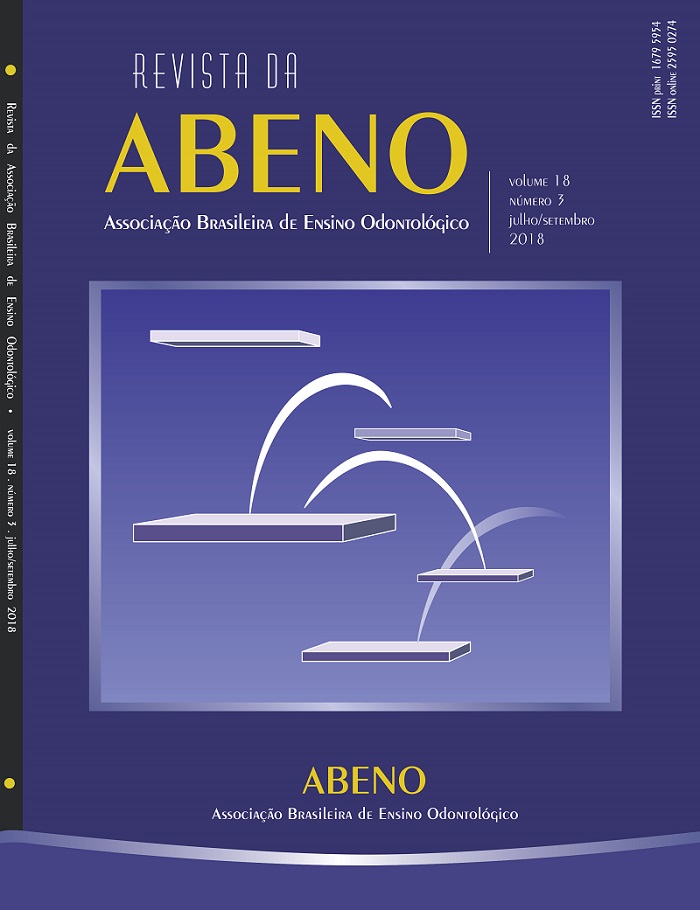Implantation of software to control the sterilization department of the Dental School of Positivo University
DOI:
https://doi.org/10.30979/rev.abeno.v18i3.542Keywords:
Sterilization. Schools. Exposure to Biological Agents. Software Validation.Abstract
This study aims to describe a method for controlling the sterilization of materials used by dentistry students and to compare its efficiency against the former control method. A software was developed by the Information Technology Management Department at the Positivo University, motivated by an internal demand to improve the sterilizing department control. The new method allows the placement of labels with bar codes on the external surface of the students’ boxes, controls the entire entrance-and-exit flow of materials and provides greater safety and agility for the sterilization process. Furthermore, the system allows professors to access the list of materials sterilized by students, and the date, time, and number of the autoclave in which the material was sterilized. Questionnaires including subjective questions about the new and former method of control were administered to final-year dentistry students to evaluate their satisfaction toward the methods. The new method decreases delays in patient care and the number of damaged and lost materials, increases safety, and reduces the time spent in material drop-off and withdrawal (p <0.05). Generally, the new method is considered better when compared to the former one (p <0.001). Therefore, we can conclude that the method implemented to control sterilization resulted in greater student satisfaction and provided greater safety.
Downloads
References
Su J, Deng XH, Sun Z. A 10-year survey of compliance with recommended procedures for infection control by dentists in Beijing. Int Dent J. 2012; 62(3):148-53.
Pimentel MJ, Filho MMVB, Santos JP, Rosa MRD. Biossegurança: comportamento dos alunos de Odontologia em relação ao controle de infecção cruzada. Cad Saúde Colet. 2012; 20(4):525-32.
Upendran A, Bhimji SS. Dental, Infection Control. Treasure Island (FL): StatPearls Publishing 2017, 29.
Lima AA, Azevedo AC, Fonseca AGL, Silva JLM, Padilha WWN. Acidentes Ocupacionais Entre Estudantes de Odontologia. Pesq Bras Odontoped Clin Integr. 2008; 8(3):327-32.
Naressi SCM, Akama CM, Silva LMP, Siviero M. Análise das formas de esterilização e do meio de controle empregados pelos cirurgiões-dentistas de São José dos Campos – SP. Rev Odontol UNESP. 2004; 33(4):169-74.
Prado MEM, Santos SSF. Avaliação das condições de esterilização de materiais odontológicos em consultórios na cidade de Taubaté. Rev Biociênc. 2002;8(1):61-70.
Oliveira CAS, Costa SM, Zocratto KBF, Branco KMGR. Avaliação microbiana da recontaminação de artigos odontológicos estéreis segundo o manuseio das embalagens. RFO UPF. 2011;16(3):256-60.
Demenech LS, Tomazinho FSF, Tomazinho PH, Gabardo MCL, Baratto-Filho F. Avaliação de métodos de manutenção da esterilidade do órgão dental humano extraído para armazenamento em banco de dentes. Rev ABENO. 2017;17(3):55-65.
Univille introduz uso de etiquetas para os prontuários de pacientes. ABENO news 2015, 47. [Acesso em 8 jul. 2018]. Disponível em: http://www.abeno.org.br/abeno-ews/abeno- news47.html.
Guandalini SL, Melo NSFO, Santos ECP. Biossegurança em Odontologia. 2ed. Curitiba: Odontex, 1999, 161p.
O'Hara NN, Patel KR, Caldwell A, Shone S, Bryce EA. Sterile reprocessing of surgical instruments in low- and middle-income countries: A multicenter pilot study. Am J Infect Control. 2015; 43(11):1197-200.
Pimentel M J, Batista Filho MMV, Santos JP, Rosa MRD. Biossegurança: comportamento dos alunos de Odontologia em relação ao controle de infecção cruzada. Cad Saúde Colet. 2012; 20(4):525-32.
Seavey R. High-level disinfection, sterilization, and antisepsis: current issues in reprocessing medical and surgical instruments. Am J Infect Control. 2013;41(5 Suppl):S111-7.
Spry C. Understanding current steam sterilization recommendations and guidelines. AORN J. 2008;88(4):537-50; quiz 551-4.
Downloads
Published
How to Cite
Issue
Section
License
Autores que publicam nesta revista concordam com os seguintes termos:
a) Autores mantém os direitos autorais e concedem à revista o direito de primeira publicação, com o trabalho simultaneamente licenciado sob a Licença Creative Commons Attribution que permite o compartilhamento do trabalho com reconhecimento da autoria e publicação inicial nesta revista.
b) Autores têm autorização para assumir contratos adicionais separadamente, para distribuição não-exclusiva da versão do trabalho publicada nesta revista (ex.: publicar em repositório institucional ou como capítulo de livro), com reconhecimento de autoria e publicação inicial nesta revista.
c) Autores têm permissão e são estimulados a publicar e distribuir seu trabalho online (ex.: em repositórios institucionais ou na sua página pessoal) a qualquer ponto antes ou durante o processo editorial, já que isso pode gerar alterações produtivas, bem como aumentar o impacto e a citação do trabalho publicado (Veja O Efeito do Acesso Livre).






